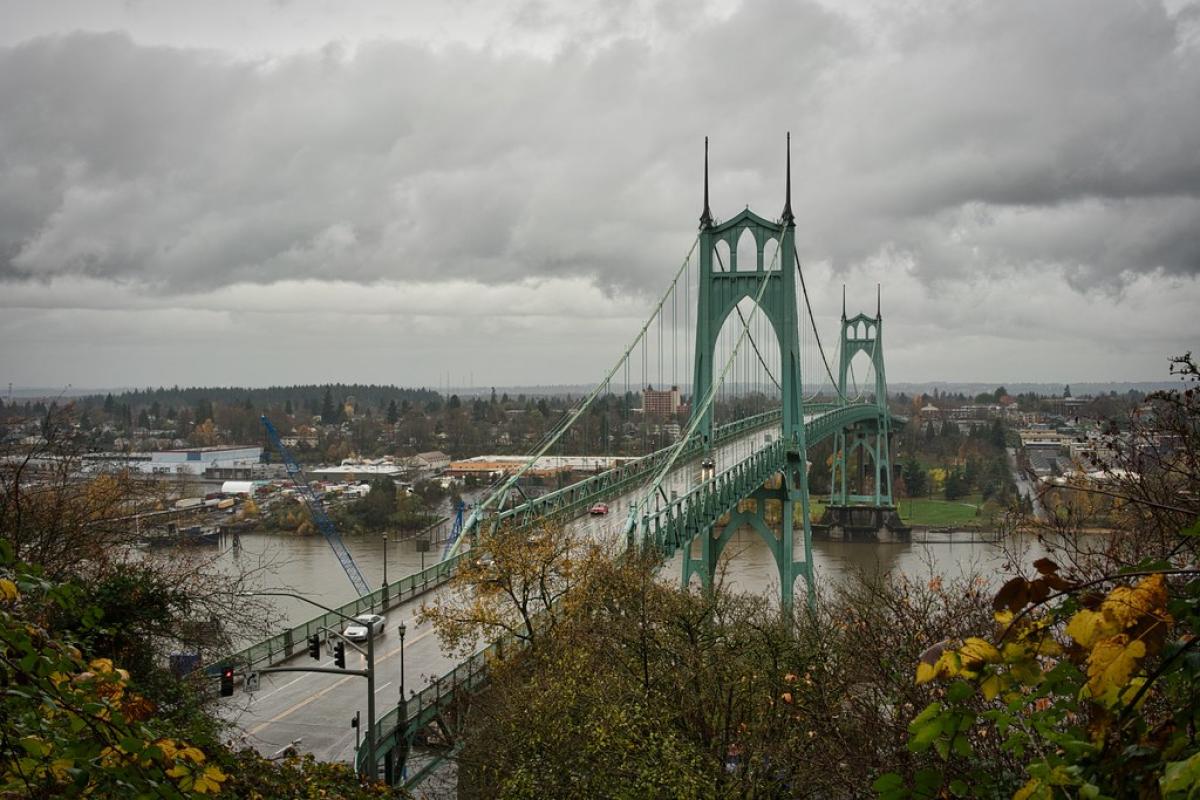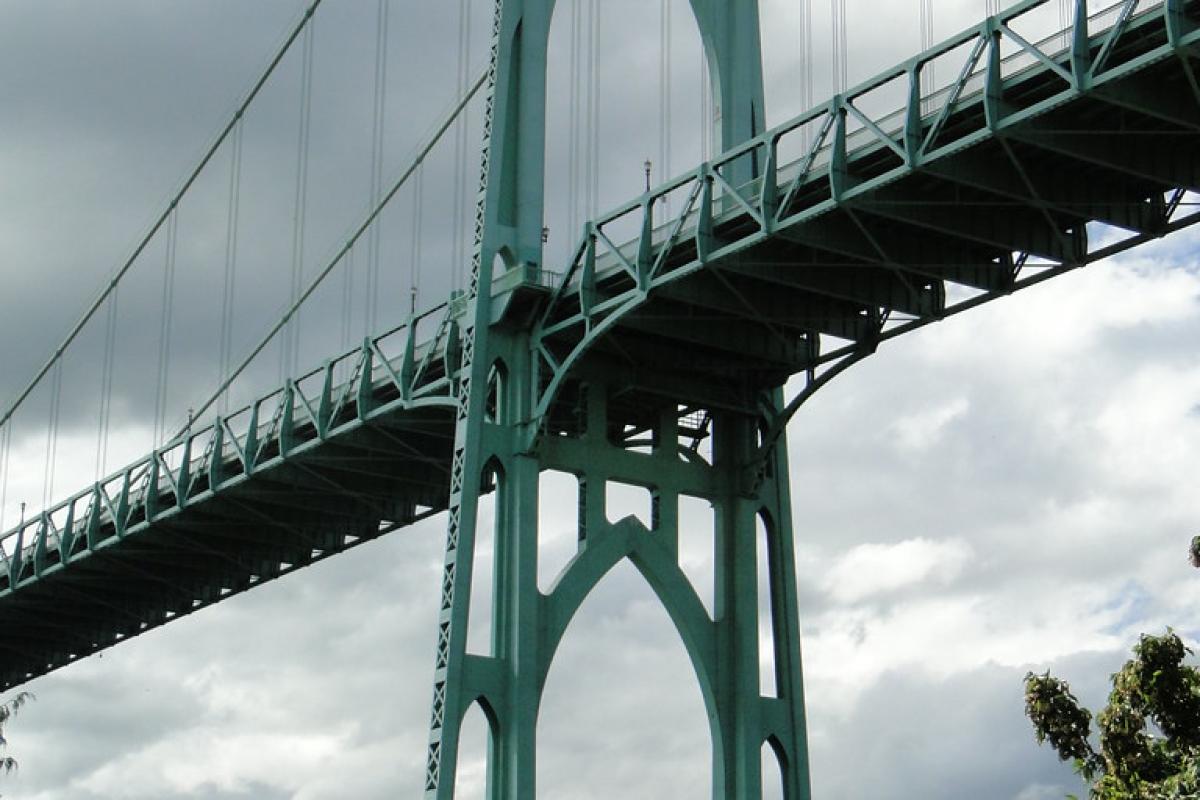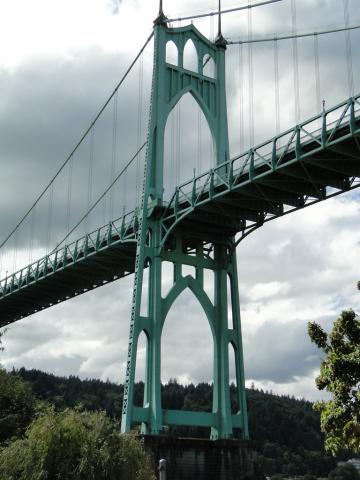Saint Johns Bridge
David Barnard Steinman (American Civil Engineer, 1886-1960)
Saint Johns Bridge
1929-1931
8600 NW Bridge Avenue, Portland, Oregon
Gothic Revival
Jake Powers, Medieval Portland Capstone Student, 2020
The St. Johns Bridge is a Gothic-inspired steel suspension bridge that presides over the Willamette River and connects the North Portland and Northwest districts. Gothic architecture continued to develop and flourish well into the 16th century, and many Gothic Revivals began to appear in England during the early 17th century.[1] By the early 19th century Gothic Revival had risen to a popular stature in the United States, as seen in the construction of the St. Johns Bridge.[2]
The St. Johns Bridge was designed by David B. Steinman in partnership with Holton Robinson. Steinman designed the bridge in 1928, and construction began in 1929. The bridge was opened on June 13th, 1931. The light-green-colored steel bridge spans 2,067 feet and has two identical towers reaching 400 feet in height. The centerpiece of Gothic architecture is the ogival arch[3], which can be viewed from the St. Johns Bridge’s two towers. At the top of each pointed tower are three Gothic cathedral-style windows. Steinman designed the bridge’s towers to emulate the same aesthetic as the medieval Gothic Cathedral’s windows and doors, demonstrated by their pointed arches.
Steinman began his career in architecture as an assistant to prominent architect Gustav Lindenthal on the Hell Gate Bridge in New York City.[4] He started an engineering firm with Holton Robinson in 1923. Steinman grew up in Manhattan near the Neo-gothic style Brooklyn Bridge, which may have influenced the design choices of the St. Johns Bridge. Both bridges have two towers with large ogival arches in each. Steinman also paid tribute to the medieval Gothic in bridges he helped design such as the Henry Hudson Bridge in New York and the Mount Hope Bridge in Rhode Island.
The St. Johns Bridge gets its name from the St. Johns neighborhood where it was constructed. The neighborhood was named after the settler James John who founded the area.[5] Gothic architecture can be said to be deeply connected to the art that was produced during its conception.[6] This feels fitting for the St. Johns bridge as the city of Portland is also revered for its relationship to art. David Steinman is quoted stating, "A bridge is a poem stretched across a river, a symphony of steel and stone."[7]
Notes
[1] Roth, Leland, and Clark, American Architecture, 2019.
[2] Roth, Leland, and Clark, American Architecture, 2019.
[3] Fletcher, A History of Architecture, 1950.
[4] Marquis, Who’s Who in America, 1968.
[5] Terry, St. John or St. Johns, 2011.
[6] Bright, Cities Built to Music, 1984.
[7] ASCE, “David Barnard Steinman.”
Bibliography
Bright, Michael. Cities Built to Music Aesthetic Theories of Victorian Gothic Revival. Columbus: Ohio State Univ. Press, 1984.
“David Barnard Steinman.” American Society of Civil Engineers. ASCE. Accessed April 30, 2020. https://www.asce.org/templates/person-bio-detail.aspx?id=11213.
Fletcher, Bannister. A History of Architecture on the Comparative Method for the Student, Craftsman, and Amateur. London: Batsford, 1950.
Marquis, Albert Nelson. Who’s Who in America: A Biographical Dictionary of Notable Living Men and Women. Chicago: Marquis, 1968.
Muhn, James, John Poppeliers, S. Allen Chambers, and Nancy B. Schwartz. “What Style Is It?” Bulletin of the Association for Preservation Technology 10, no. 2 (1978): 154. https://doi.org/10.2307/1493624.
Roth, Leland M., and Amanda C. R. Clark. American Architecture: A History. New York: Routledge, 2019.
Terry, John. “St. John or St. Johns? Portlanders Have Long Debated the Neighborhood's Name.” The Oregonian, November 26, 2011.






